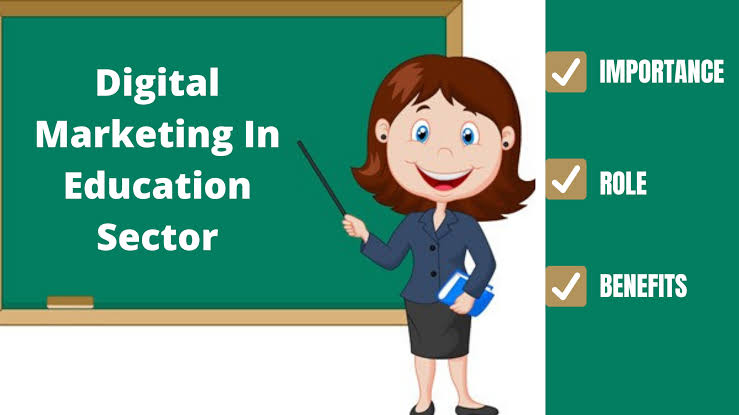Digital marketing has transformed the educational sector by providing powerful tools for outreach, personalization, and engagement. It allows institutions to connect with students in meaningful ways, expand their reach globally, and create lasting impressions that drive enrollment and loyalty.
Digital marketing has become a crucial tactic in almost every industry, including education, in today's more interconnected world. As of June 2025, technological developments, shifting student expectations, and increased competition among educational institutions are all contributing to the growing role of digital marketing in education. Digital marketing is changing how educational providers recruit, engage, and retain students in all settings, from elementary schools to universities, and from online courses to skill-based programs. In the context of education, the capacity to convey value, establish credibility, and provide relevant content is now more crucial than ever.
Comprehending Digital Marketing in the Academic Field
The use of online platforms, tools, and tactics to advertise educational services, engage students, and enhance learning is known as digital marketing in the field of education. Content marketing, SEO, email campaigns, pay-per-click (PPC), social media outreach, and other techniques are all included in this broad category. In addition to growing student enrolment, the objective is to improve the institution's standing, improve communication, and establish enduring relationships with stakeholders, alumni, and students.
Institutions must now meet prospective students where they are—online—due to the shift in learning platforms towards digital ones. Institutions can no longer rely only on conventional strategies like brochures, billboards, and print ads because of mobile-first behaviours and the growth of social media platforms like TikTok, Instagram, and YouTube.
Increasing Outreach and Visibility
The potential of digital marketing to increase visibility and broaden outreach is among its most important effects in education. Geographical boundaries no longer apply to schools and universities. They can now reach students worldwide as well as in their local communities through digital channels. Institutions can reach a larger audience by promoting their offerings through social media campaigns, SEO tactics, and paid search ads.
For instance, to draw in potential students from Nairobi, Accra, or even New York, a small coding bootcamp in Lagos can employ targeted digital advertisements. Institutions can influence enrolment decisions by offering a glimpse of their environment and learning experience through webinars, virtual tours, and live Q&A sessions.
Tailored Interaction and Content Distribution
Personalisation has emerged as a crucial differentiator in a market full of options. With the help of digital marketing, schools can customise their messaging to the unique needs, interests, and habits of potential students. Institutions can divide up their audience and provide tailored content, like course recommendations, scholarship opportunities, or success stories, by utilising tools like marketing automation software and customer relationship management (CRM) systems.
A key component of this strategy is content marketing. Schools can inform prospective students about programs, industry trends, and career opportunities through case studies, eBooks, videos, podcasts, and blogs. A university that offers data science programs, for example, might release articles about developments in AI or alumni interviews that highlight professional advancement.
Increasing Enrolment and Student Recruitment
By establishing several touchpoints throughout the student journey—from awareness to consideration to decision-making—digital marketing streamlines the student recruitment process. Institutions can remind interested parties about open days, application deadlines, and admission requirements by using retargeting campaigns. Chatbots, virtual assistants, and interactive landing pages can help students with the enrolment process by providing real-time answers to their enquiries and lowering application barriers.
By 2025, organisations will be able to monitor user engagement and behaviour more accurately than before thanks to data analytics tools. Marketers are better able to allocate resources and improve their strategies thanks to these insights. Institutions can increase their recruitment ROI and lower drop-off rates by knowing which channels convert the most applications or which messages resonate the best.
Increasing Credibility and Brand Positioning
In the field of education, reputation is a potent source of influence and trust. Institutions can establish and sustain a strong brand presence with the help of digital marketing. Positive student evaluations, active social media accounts, and thought leadership content all enhance an institution's reputation and legitimacy. Perception of educational brands is also significantly influenced by search engine visibility.
While a weak online presence may cause potential students to doubt an institution's legitimacy, high search engine rankings indicate authority and dependability. In this way, SEO and content optimisation are tools for reputation management rather than merely marketing tactics. Another powerful strategy for enhancing a brand is digital storytelling.
Encouraging Hybrid and E-Learning Models
Digital marketing's function goes beyond hiring; it also helps with the actual delivery of education. As online and hybrid learning models continue to expand, educational providers are using digital marketing tools to advertise new courses or modules, retain students, and encourage participation.
Email campaigns can be used to share learning materials, advertise new programs, or remind students of impending assignments. Mobile apps can provide alerts, updates, and tailored suggestions, while social media groups can promote community development and peer-to-peer interaction. These resources help create a more stimulating and encouraging learning environment, which boosts student retention and satisfaction.
Accepting Innovation and Upcoming Patterns
As new technologies are developed, the function of digital marketing in education will also continue to change. Data analytics, virtual reality, and artificial intelligence will all have a bigger impact on how educational institutions interact with students. For example, chatbots driven by AI can offer immediate academic counselling, and VR-enhanced virtual tours can give distant prospects immersive experiences.
Additionally, gamification may become more widely used in marketing strategies, transforming engagement and recruitment into fun and interactive processes. Institutions will be better positioned to prosper in the market for digital education if they keep ahead of these trends and make innovative investments.
